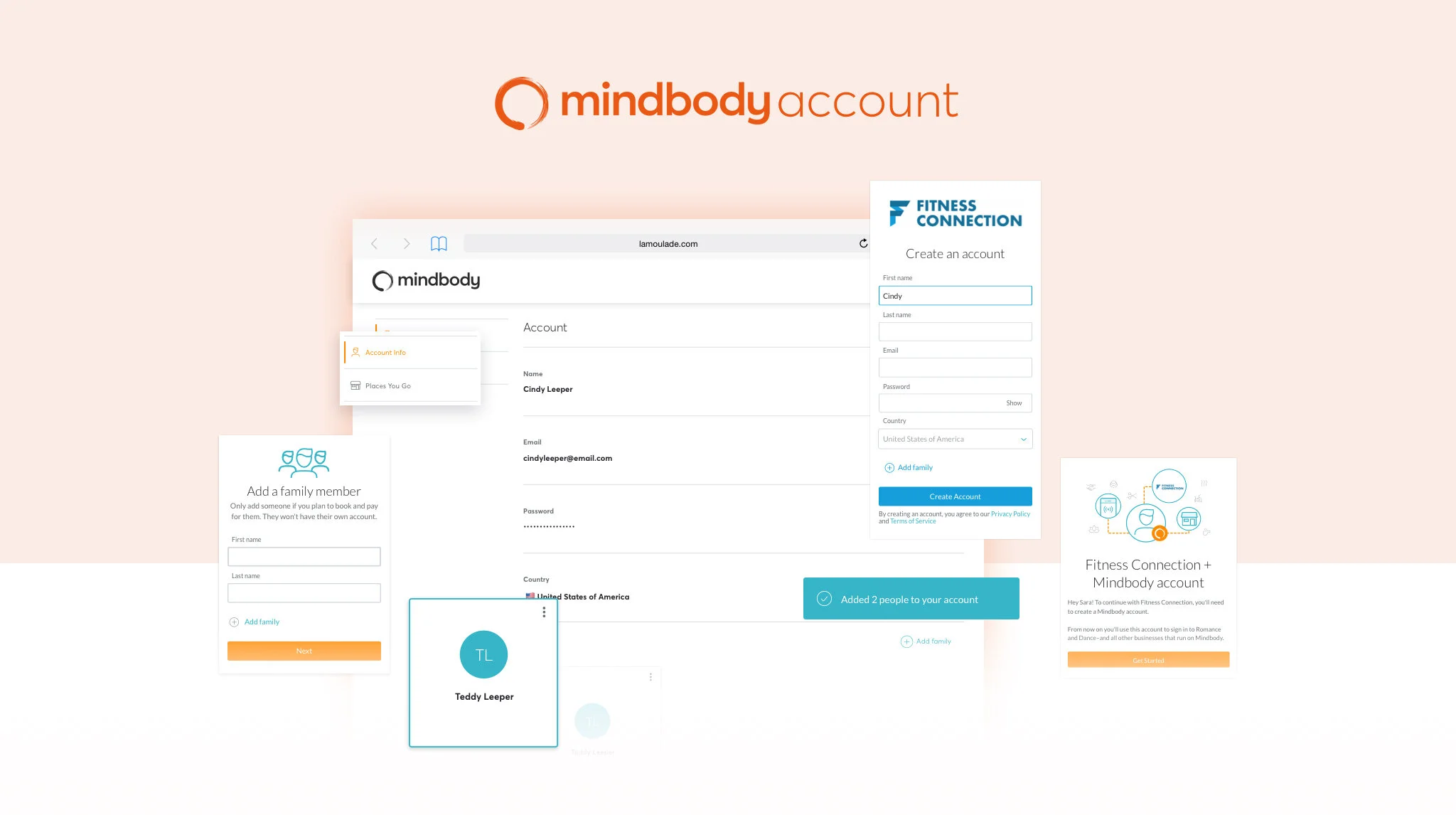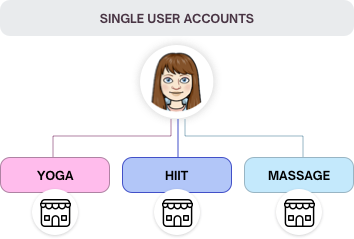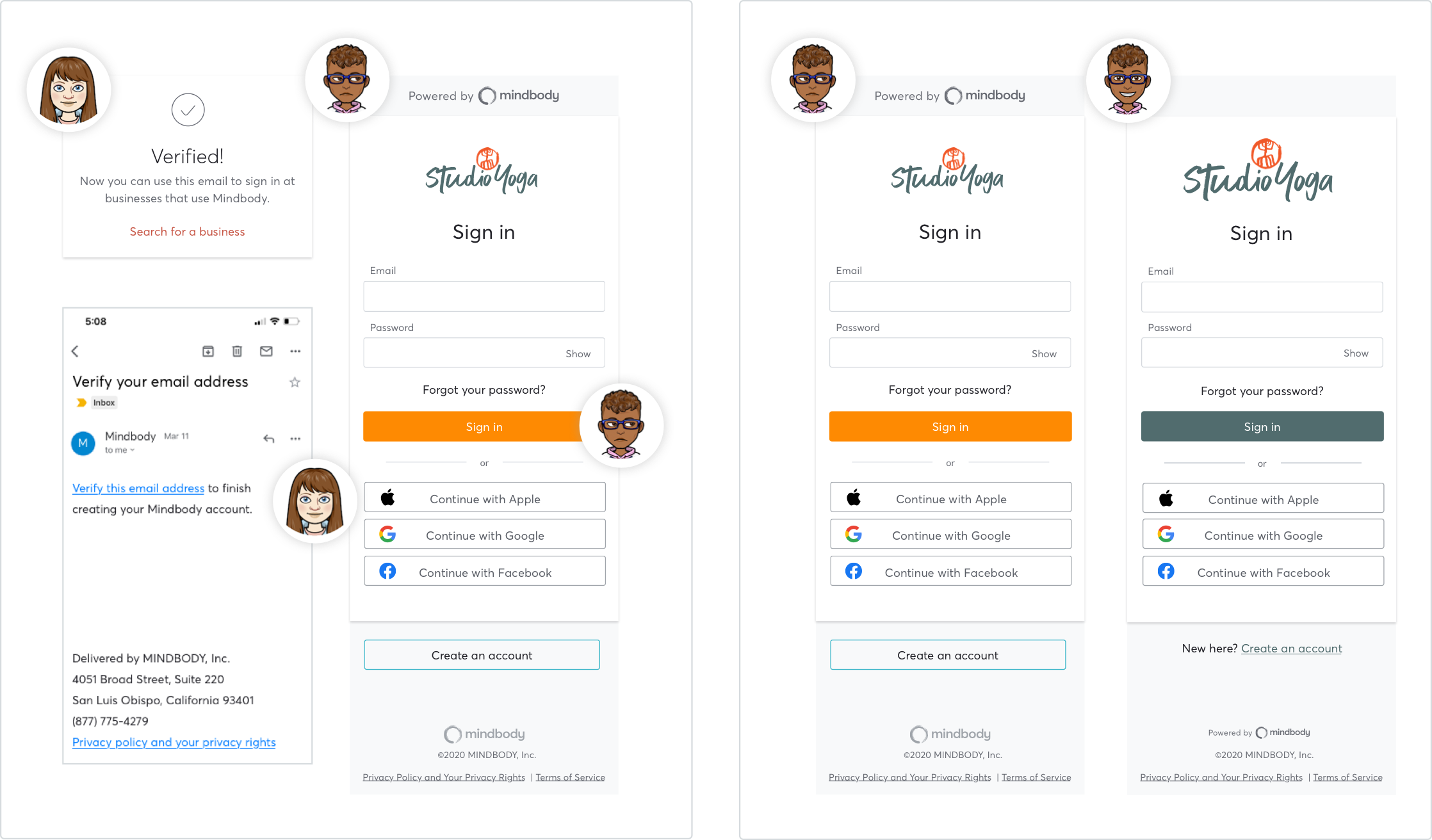Designing the Mindbody account
The Problem
Historically, when a business owner bought Mindbody, that business was seen as a separate entity. When people created an account, it only worked at that business. Over time, peoples' wellness habits evolved to include more variety, which meant they could have multiple logins at various businesses. Having to remember multiple credentials was taxing on people and families. This led to issues with sign-in and other account-related activities to be the number one support call to Mindbody.
Solution
Our team designed a holistic identity and account management experience for all Mindbody products. This project improved our legacy products and launched the Mindbody account (seen below). This work touched every product from the web to native.
My role
I led a design team of two to understand the problem space, define workflows, execute the visual design according to our design system, and manage developer hand-off. I worked with integration teams to identify integration touchpoints and maintain copy and design standards.
Erin at the whiteboard
Understanding people and their problems
A common issue was people could not find purchases. Using a journey map we stepped through the existing problem to find opportunities.
Opportunities
For Cam, mismatched emails and duplicate profiles led to purchases going astray. She also had 2 credentials for that business but didn’t realize it.
For Owen, the task of searching for profiles and sending verification emails takes business him anywhere from 5-20 minutes, depending on how many duplicate profiles needed review. In some cases, businesses have a front desk person whose job it is to merge duplicate accounts.
Because of limits in scope, we decided to focus on Cam's opportunities for this first round of design, focusing on a universal account concept.
How might we create an account that consumers can access across businesses?
We used Zoom, InVision Freehand, and pen and paper to quickly ideate using crazy 8's. We created concepts around a universal account, how people could access it, and branding.
Concepts generated: 32
Assumptions documented:
Do people know what Mindbody?
Do they realize they use Mindbody to book services?
Businesses have their brands and don't want to share space with Mindbody
This Co-branding confuse customers
Moving forward with building a universal account
Defining account information vs. Profile information
We had high confidence people would understand concepts of accounts and profiles. The place where we wanted to focus was that StudioYoga would manage profile information and Mindbody would manage account information.
Single User Accounts
For single users who like variety in their wellness routines, they would have separate profiles at each business with information like; loyalty points, allergies, before and after pictures that only pertain to that business.
Family accounts
The concept of account management becomes even more critical when designing for families. A parent with kids in dance class doesn't take classes at that business but still needs to be in charge of booking and buying.
User testing brand balance
Mindbody uses a branded house strategy when designing; we strive for single-brand harmony across all products. With this strategy comes particular challenges in the B2B2C software space. The sign-in page is like a virtual front door to the business. Businesses have worked hard at establishing equity in their brand.
We tested with consumers to gauge their understanding of the Mindbody account and business owners to gauge sentiment towards co-branding.
“I know Mindbody because I use the app”
“I thought Mindbody was the name of the gym”
“I don’t want to share space with the Mindbody logo”
“Can we make this look like my website?”
Recommendations from testing
Use the term full term "Mindbody account" when referencing account management topics like resetting passwords. Since you would be resetting your Mindbody password and not studio password.
Create a tool to customize all identity screens to better align with business branding.
Reduce “Powered by Mindbody” branding from screens
UI customization tool with
accessibility alert
I designed a UI customization tool so that businesses can brand their sign-in screens. I knew accessibility would quickly become an issue. Working with my developer, we created an alert system that would alert and suggest AA-compliant colors.
Introducing
Mindbody account
The Mindbody account allows individuals and families to sign in with the same email and password to any business that runs on Mindbody. Additionally, we created an account management website where people would manage account information for themselves and their family members.
Across the product ecosystem, this shared UI replaced all sign-in screens across Mindbody. Consumers could quickly sign in and not create duplicate accounts. Also, this significantly reduced development costs for Mindbody.
Final Identity Workflow
An email was used as a unique identifier to link businesses to existing profiles. We found from data the 54% of sign-in are from social sign-in. Since that was the primary and fastest way to sign in, we put this first (later iteration).
UI's I designed:
Sign in
Forgot password
Create an account and email verification
Create an account with family
Migration (existing users need to migrate to Mindbody accounts)
Account management website (above)
Results and Reflections
Designing for an entire ecosystem of products is a big task, and it takes time and sensitivity to understand how new experiences and language fit into older software. When we released account.mindbodyonline.com, we assumed people would be most likely to updates email, but we saw a sharp increase in people updating names. We figured changing maiden names was the primary use for the feature. Family accounts rollout paused due to integrations taking longer than we'd expected..
Ideas I will take with me:
Creating a glossary of shared language helped the team communicate more effectively.
Document everything! Context can be easily lost on long-term projects.
Stay organized! As Bruce Mau said in his Incomplete Manifesto for Growth Organization = Liberty. As a designer, anyone needs to be able to jump into my file and understand current work.
Time and resources are always going to be scarce, and code is sometimes dusty, but this should not get in the way of delivering a great experience. Stick to your guns, but also be flexible.











